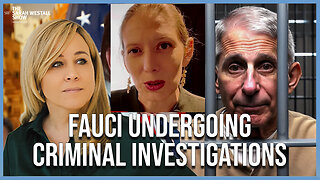Premium Only Content

The Corruption of the Banking System
The Corruption of the Banking System
The rise of monetary economies assisted two significant changes to society: First, since the fruit of one's labor was now monetized and so could be exchanged freely, it allowed for the specialization of labor. Second, thanks to monetization, individuals could more easily save for the future. By allowing for savings and capital formation, human societies were able to advance beyond subsistence farming. But with savings came another critical issue: security. The banking industry allowed consumers to keep their gold or silver in protected vaults, and in return, they received paper receipts, which are easier to carry than heavy metal coins. The receipt entitled the owner to claim his goods any time he desired, like keeping personal items in a warehouse. Since any holder of the receipt could claim the gold, convenience inevitably led to the transfer of these paper notes instead of the metal itself. The receipts for money become money substitutes. So long as the bank had as much gold as it does banknotes—which is called full-reserve banking—there would be no increase in the money supply. What if, however, the bank realized that money kept in the bank is not needed all at once? A bank could lend out a customer's money, profit from the loan, and then return the money to the customer's account before it is withdrawn. If a customer closed their account unexpectedly, the bank could borrow from another account to make up the difference. This is fractional reserve banking, and this is how almost all banks operate today. In doing so, big banks have become very profitable—but the economic consequences complicate the issue of money. For example, let us say that a hundred gold coins enter a bank account. The bank account only keeps 10 percent reserves in an account, so it lends out ninety gold coins. Fifty of those ninety gold coins end up in another customer's account at the bank, and now the bank lends out forty-five of those coins. From that first deposit of one hundred coins, the original customer currently has a receipt for one hundred coins, another customer has a receipt for fifty coins, and there are an additional 135 coins’ worth of loans on the market. The result is an expansion of paper receipts—money substitutes—in the market, without any increase in gold to support it. This arrangement is also different than if the original customer directly loaned out fifty coins instead, because with such a loan, the lender would have no expectation of being able to access the borrowed money. These unbacked banknotes, like counterfeiting a coin, are an example of inflation, which may be defined as an increase in the economy's supply of money that is not due to an increase in the monetary base–actual gold coins, in this case. These "fractional reserve banks," therefore, are inherently inflationary institutions. Whether this additional money is created by the direct printing of new money, or through multiplication in a fractional reserve system, the result is an increase in the money supply not reflected in an increase of wealth in the real economy. This will create additional issues we will explore later. Another issue with fractional reserve banking arises if customers lose confidence in the bank: they rush to take their money back. Bank panics are devastating, not only because a large withdrawal of money from an overleveraged bank hurts other customers, but because it can lead to better-managed banks being similarly stressed in ways they did not anticipate. As such, many of the criticisms of "instability" prior to the Federal Reserve have little to do with gold as money and everything to do with the lending practices of banks themselves. Many of the problems, as we will see, resulted directly from government policy designed to increase control over money and banking. To understand money as it exists today, far removed from any sort of commodity, we must understand why control over money is so important to the state. ______________________________________ This series was inspired by Murray Rothbard's classic introduction, What Has Government Done to Our Money?—available for free in PDF, ePub, HTML, and Audiobook at https://Mises.org/WHGD To learn more about the operations of the Federal Reserve, check out Bob Murphy's book, Understanding Money Mechanics, available for free in PDF, ePub, and HTML at https://Mises.org/BobMoney
-
 1:34
1:34
Government news
2 years agoNord Stream Pipelines 1 And 2, Shows Gas Leaks.
245 -
 1:52:05
1:52:05
IsaiahLCarter
16 hours ago $3.78 earnedAPOSTATE RADIO #013: Congestion Pricing is For The Dogs (feat. Charlie Panoff, Danny Perlstein)
37.8K13 -
 1:52:17
1:52:17
KINGKILLJ0Y
7 hours agoWhen it's DARK....it's time for RANK! //🔴LIVE
33.9K5 -
 2:06:49
2:06:49
Tundra Tactical
8 hours ago $9.39 earnedStar Wars Blaster Rankings and Other Galactic Gun News On The Galaxies Okayest Gun Live Stream
47.7K3 -
 2:09:29
2:09:29
Nerdrotic
10 hours ago $18.18 earnedAncient Precision Stone Vases Discoveries | Forbidden Frontier 100
79K10 -
 5:44:01
5:44:01
EricJohnPizzaArtist
9 hours agoAwesome Sauce PIZZA ART LIVE Ep. #46: Celebrating ONE YEAR on RUMBLE and Star Wars Day!
61.7K5 -
 6:53:09
6:53:09
iCheapshot
9 hours ago $3.77 earnedSunday Funday | Warzone Vibes
33.6K5 -
 54:50
54:50
Sarah Westall
10 hours agoTwo States Start Criminal Investigations against Fauci and Friends w/ Attorney Rachel Rodriguez
52K53 -
 3:15:51
3:15:51
BubbaSZN
7 hours ago🔴 LIVE - BACK TO RACING IN MEXICO (FORZA HORIZON 5)
18.8K1 -
 LIVE
LIVE
Major League Fishing
6 days agoLIVE! - Bass Pro Tour: Stage 4 - Day 4
2,059 watching